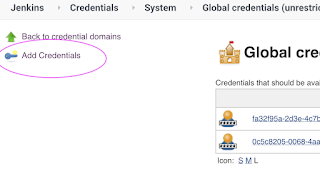We will learn how to automate Docker builds using Jenkins and Deploy into Kubernetes Cluster setup using AKS. We will use Python based application. I have already created a repo with source code + Dockerfile. The repo also have Jenkinsfile for automating the following:
- Automating builds using Jenkins
- Automating Docker image creation
- Automating Docker image upload into Docker registry
- Automating Deployments to Kubernetes Cluster
- Automating builds using Jenkins
- Automating Docker image creation
- Automating Docker image upload into Docker registry
- Automating Deployments to Kubernetes Cluster
Pre-requisites:
1. AKS Cluster is setup and running. Click here to learn how to create AKS cluster.
1. AKS Cluster is setup and running. Click here to learn how to create AKS cluster.
2. Jenkins Master is up and running.
3. Setup Jenkins slave to run Docker builds
4. Docker, Docker pipeline and Kubernetes Deploy plug-ins are installed in Jenkins
4. Docker, Docker pipeline and Kubernetes Deploy plug-ins are installed in Jenkins
Step #1 - Create Credentials for Docker Hub
Go to Jenkins UI, click on Credentials -->
Click on Global credentials

Now Create an entry for your Docker Hub account. Make sure you enter the ID as dockerhub
Step #2 - Create Credentials for Kubernetes Cluster
Click on Global credentials
Click on Add Credentials

Now Create an entry for your Docker Hub account. Make sure you enter the ID as dockerhub
Click on Add Credentials, use Kubernetes configuration from drop down.
execute the below command to get kubeconfig info, copy the entire content of the file:
sudo cat ~/.kube/config
Enter ID as K8S and choose enter directly and paste the above file content and save.
Step # 3 - Create a pipeline in Jenkins
Step # 4 - Copy the pipeline code from below
Make sure you change red highlighted values below:
Your docker user id should be updated.
your registry credentials ID from Jenkins from step # 1 should be copied
label 'myslave'
}
environment {
//once you sign up for Docker hub, use that user_id here
registry = "your_docker_hub_user_id/mypython-app"
//- update your credentials ID after creating credentials for connecting to Docker Hub
registryCredential = 'dockerhub'
dockerImage = ''
}
stages {
stage ('checkout') {
steps {
checkout([$class: 'GitSCM', branches: [[name: '*/master']], doGenerateSubmoduleConfigurations: false, extensions: [], submoduleCfg: [], userRemoteConfigs: [[url: 'https://github.com/akannan1087/myPythonDockerRepo']]])
}
}
stage ('Build docker image') {
steps {
script {
dockerImage = docker.build registry
}
}
}
// Uploading Docker images into Docker Hub
stage('Upload Image') {
steps{
script {
docker.withRegistry( '', registryCredential ) {
dockerImage.push()
}
}
}
}
stage ('K8S Deploy') {
steps {
script {
kubernetesDeploy(
configs: 'k8s-deployment.yaml',
kubeconfigId: 'K8S',
enableConfigSubstitution: true
)
}
}
}
}
}
Make sure you change red highlighted values below:
Your docker user id should be updated.
your registry credentials ID from Jenkins from step # 1 should be copied
pipeline {
agent {label 'myslave'
}
environment {
//once you sign up for Docker hub, use that user_id here
registry = "your_docker_hub_user_id/mypython-app"
//- update your credentials ID after creating credentials for connecting to Docker Hub
registryCredential = 'dockerhub'
dockerImage = ''
}
stages {
stage ('checkout') {
steps {
checkout([$class: 'GitSCM', branches: [[name: '*/master']], doGenerateSubmoduleConfigurations: false, extensions: [], submoduleCfg: [], userRemoteConfigs: [[url: 'https://github.com/akannan1087/myPythonDockerRepo']]])
}
}
stage ('Build docker image') {
steps {
script {
dockerImage = docker.build registry
}
}
}
// Uploading Docker images into Docker Hub
stage('Upload Image') {
steps{
script {
docker.withRegistry( '', registryCredential ) {
dockerImage.push()
}
}
}
}
stage ('K8S Deploy') {
steps {
script {
kubernetesDeploy(
configs: 'k8s-deployment.yaml',
kubeconfigId: 'K8S',
enableConfigSubstitution: true
)
}
}
}
}
}
Step # 5 - Build the pipeline
Once you create the pipeline and changes values per your Docker user id and credentials ID, click on
Step # 6 - Verify deployments to K8S
kubectl get pods
kubectl get deployments
Steps # 7 - Access Python App in K8S cluster
Once build is successful, go to browser and enter master or worker node public ip address along with port number mentioned above
http://master_or_worker_node_public_ipaddress:port_no_from_above
You should see page like below:
Please watch the above steps in YouTube channel:



















Hi
ReplyDeleteI followed the above steps. The pipeline built was successful but when I run kubectl get pods the status of the pods is ImagePullBackOff. Any suggestions to make the pods running/
By default it will Search for latest Tag. So update below Step
Delete// Uploading Docker images into Docker Hub
stage('Upload Image to Docker HUB') {
steps {
script {
docker.withRegistry('', registryCredential) {
dockerImage.push()
dockerImage.push('latest')
}
}
}
}
This comment has been removed by the author.
ReplyDelete